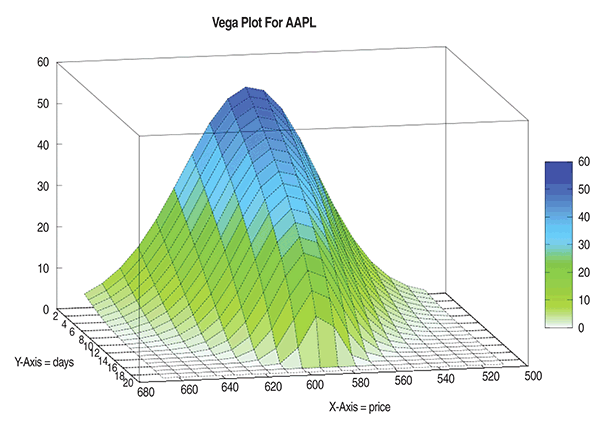
FIGURE 1: VEGA PLOT FOR AAPL LONG CALL OPTION. Here you see a three-dimensional plot of vega of a long call for the last 18 days before expiration. Each day, vega declines till it reaches zero at expiration.
OPTIONS
Implied Volatility And Its Effects
The effects of implied volatility are underestimated by many option traders. It can vary greatly and unpredictably over an option’s life and have a negative impact on the profitability of an option position.
Option volatility, referred to as implied volatility (IV), is reflected in the option price through an option’s vega. Vega is defined as an option’s sensitivity to changes in the implied volatility of the option. It is expressed as the change in the option’s value as implied volatility rises or falls by 1%. Vega is negative for short options and positive for long options. For example, assume a call option has an implied volatility of 15%, the theoretical price of the long call option is 1.50, and the vega of the option is 0.30. If the volatility increases from 15% to 16%, the theoretical price of the option will increase to 1.80. Conversely, if the option is a short call, the theoretical price will decrease to 1.20. An option’s vega decreases toward zero as the option moves deeper in-the-money (ITM) or farther out-of-the-money (OTM).
The vega is maximum at the option’s strike price and declines exponentially at prices above and below this price. Vega also decreases as time passes. Figure 1 shows a three-dimensional plot of the theoretical vega of a long call for the last 18 days before an option’s expiration. Assuming a constant implied volatility, you can see that each day, vega declines till it reaches zero at expiration.

FIGURE 1: VEGA PLOT FOR AAPL LONG CALL OPTION. Here you see a three-dimensional plot of vega of a long call for the last 18 days before expiration. Each day, vega declines till it reaches zero at expiration.
One of the best trades that shows the impact of volatility changes are stock earnings plays. These are short-term options trades made just before a company releases earnings, hoping to capture a quick profit as a result of greater than normal price movement due to companies beating or missing analysts’ profit expectations.
THE LONG STRANGLE
One popular strategy for earnings plays is a long strangle. With this strategy, a trader buys an out-of-the-money put and call option with the same expiration date that expires closest to the day after earnings release. The trade is profitable at expiration if the stock price movement is greater than the upper strike price plus the premiums paid or less than the lower strike price minus the premiums paid for the options, but the plan is to be out of the trade in a day.